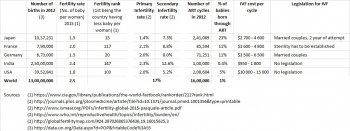10/09/2017
Fertility, infertility, assisted reproduction and medical tourism in India
Recently an Indian la dy came to my office to discuss about about infertility and breastfeeding. Curious, I asked almost immediately what is India’s rank in terms of infertility on a global scale. I had been curious about that for a while actually, as I see more and more ‘infertility centers’ popping up everywhere in the last few years.
dy came to my office to discuss about about infertility and breastfeeding. Curious, I asked almost immediately what is India’s rank in terms of infertility on a global scale. I had been curious about that for a while actually, as I see more and more ‘infertility centers’ popping up everywhere in the last few years.
Her answer surprised me: according to her, the countries most affected by infertility are Japan and Germany. Who would have thought? I wouldn’t, neither did I believe it…
So I dug a little and soon discovered that it is actually almost impossible to find a clear answer to my question; for one thing the infertility criteria vary from one country to another, making it almost impossible to make any world ranking and also because censuses can only be far from comprehensive – all the people who do not reproduce don’t necessarily get checked for infertility.
What could she mean then? Did she mistake infertility rate (or number of people who can not conceive a child) and fertility rate (or number of births per woman)?
India is a country where women justify their presence in the world only when they become a mother – that is still strongly the case and that’s why we see very old ladies becoming first time mothers (source). Taking this into account, I wouldn’t be too surprised if, for her, when a woman has no child it is not a question of choice but just because she can’t.
But even then, Japan and Germany are not on top of the least fertile countries (see table below).
Where Japan ranks first, however, is in the number of births using ART (Artificial Reproductive Technology). Perhaps she mistook infertility and assisted reproduction?
Both are not the same. One can for instance imagine that in some countries (like Japan) parents rely more on medical assistance than in other countries, not only because they are medically infertile, but also because they do not have sex (no time, no desire (source)), or because ART is affordable or covered by insurances, or because of some other reasons. I make this assumption because if Japanese champion the number of assisted procreations, their infertility rates appear to be even lower than elsewhere (see table below). In short, there is no evidence that the Japanese face more difficulties to conceive, but everything indicates that the use of a medical assistance has become quite common.
But let us get back to our Indian business. The numbers that I’ve gathered suggest that 45% of couples suffer from infertility in India (source) but less than 1% of the affected couples seek medical advice (source).
And yet I see boards at almost every street corner, signaling a clinic specializing in the treatment of infertility. And almost every gynecologist now claims to be an IVF specialists.
In short, it is almost impossible to tell if there are more procreations medically assisted in India because 1. There is an increasing number of infertile couples in India – a hypothesis linked to urbanization rates, obesity trends, number of women with professional careers rising up, hypothesis put forward by the media; 2 Indians are increasingly going past the social stigma associated with the state of infertility and seek more official medical help (because I’m sure there are many cases not reported, we know already that 60% of ‘physicians’ in India have no medicine degree (source)); 3. Doctors have found a honey pot and invest on it – the less ethical ones would not hesitate too much before inseminating or implanting an embryo in Indian couples with non-existent sex life rather than counselling them, other ones focusing on the international patient base who more and more comes to India to make a baby because it is three times cheaper here than in the United States (see table below); Or probably it is a mix of all these factors.
A small digression to conclude: India seems to be the hub of parenthood. Apart from the medical tourism of fertilization, there is the adoption business or even the business of surrogacy. India got famous about this abroad in 2007, when an Oprah’s show staged a Western couple going to India and its plethora of surrogate mothers. Because it took too important proportions – foreigners (and Indians) doing their shopping and surrogates being paid peanuts (since agents and doctors keep the jackpot for themselves), the Government tried to put an end to this in 2016. Which means they prohibited surrogacy purely and simply*. It’s easier to ban than to put controls in place. Although it encourages the development of the black market of surrogacy and it is the surrogate mothers who end up suffering the most.
It’s kind of what happened with adoption. Until the 1970s, India had more and more orphans and Indians were reluctant to adopt – because of the social stigma, and the apprehension of bringing someone in the family that they know nothing about, with caste requirements and all (source). But foreigners were keen on adopting. Which obviously led to some derivatives, such as theft and trafficking of kids by some ill-intentioned Indians. Following scandals in the 1990s, India toughened the laws and made every adoption difficult, even for Indians. However it seems that the Government has been making the rules related to adoption easier since 2015.
* After the new law (source) only an Indian couple having tried without success to have a baby for more than five years can have recourse to a surrogate mother, who must be from the family, and they will only pay for the medical expenses, no incentive.
Sources : http://www.prsindia.org/billtrack/the-surrogacy-regulatio...? ; https://www.cia.gov/library/publications/the-world-factbo... ; https://www.palashivf.com/2017/02/21/ivf-treatment-market... ; http://www.ey.com/Publication/vwLUAssets/EY-call-for-acti... ; http://www.dailyo.in/lifestyle/infertility-on-the-rise-in... ; http://www.who.int/reproductivehealth/topics/infertility/... ; http://journals.plos.org/plosmedicine/article?id=10.1371/... ; http://www.ijsr.net/archive/v4i7/SUB156201.pdf ; http://www.aurumequity.com/ivf-india/ ; https://www.researchgate.net/publication/236005514_Adopti...
08:00 Posted in Incredible India! | Permalink | Comments (0) | Tags: india, fertility, infertility, ivf, art, cost, comparison | ![]() Facebook | |
Facebook | |
















The comments are closed.